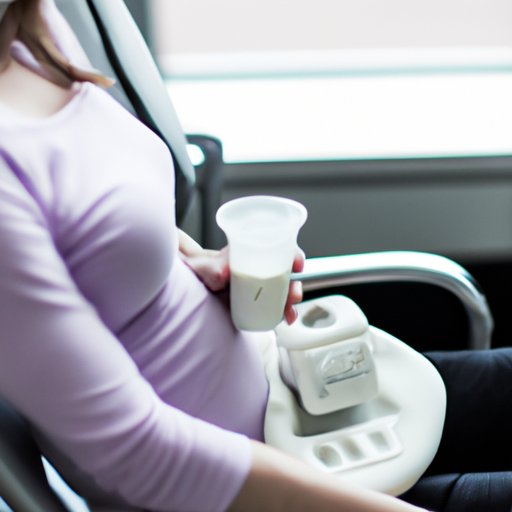Introduction
For breastfeeding moms, pumping while traveling can be a daunting task. With so many factors to consider, it’s easy to feel overwhelmed. But with some preparation and planning, pumping while traveling doesn’t have to be so stressful. In this article, we will explore how to make pumping while traveling easier.
Pumping while traveling essentially means expressing milk away from home, usually in a different environment than usual. This could mean pumping at an airport, in a hotel, or even in a car. No matter where you are, the goal is to keep up your milk supply while on the go.
There are several common challenges that come with pumping while traveling. For starters, you may have limited access to electricity, meaning you may not always be able to use your regular electric pump. You also may have limited space to store pumped milk, as well as limited privacy when it comes to finding a place to pump. All of these issues can add stress to already hectic travel plans.

Prepare Your Pump Ahead of Time
The first step in making pumping while traveling easier is to prepare your pump ahead of time. Before you leave, make sure to check airline regulations and policies regarding breast pumps. Most airlines allow them, but some may require that you check the pump as luggage. Knowing the rules ahead of time will help you avoid any last-minute hassles.
You should also make sure that all of the pump parts are clean and that you have packed all necessary supplies. If you’re using a manual pump, make sure you have extra batteries just in case. And if you’re using an electric pump, make sure you have the right power adapter for wherever you are traveling.
Pack the Right Supplies
When packing for your trip, make sure to include all the supplies you’ll need for successful pumping while traveling. A hands-free pumping bra can be a great way to make pumping more convenient. The bra holds the bottles in place, freeing up your hands to do other things like read or answer emails.
It’s also a good idea to invest in a portable battery pack. This way, you can plug in your pump anywhere, even if there isn’t an outlet nearby. Just make sure to double-check the voltage requirements for your pump before purchasing a battery pack.
Finally, don’t forget to bring a cooler bag for storing your expressed milk. Most airports have special coolers specifically designed for breastmilk storage, but it’s always better to be prepared just in case.

Make Use of Airport Breastfeeding Rooms
Many airports now offer special breastfeeding rooms for nursing mothers. These rooms typically provide a comfortable place to sit, as well as access to a sink and a refrigerator for milk storage. Some airports even offer private pumping rooms for added privacy.
Using airport breastfeeding rooms can make pumping much easier. Not only do they provide a quiet, comfortable place to pump, but they also allow you to store your milk until you board your flight. That way, you don’t have to worry about lugging around a cooler full of milk during your travels.
Pump Whenever You Have a Chance
If you don’t have access to an airport breastfeeding room, don’t worry. There are plenty of other places where you can find a quiet corner to pump. Just make sure to set a timer to remind yourself when to start and stop. That way, you won’t miss your flight or any other important appointments.
If possible, try to pump whenever you have a chance. Even if it’s just for a few minutes, every little bit helps. And don’t be afraid to ask for help if you need it. Many airports have lactation consultants who can give you advice and support.
Conclusion
Pumping while traveling doesn’t have to be overwhelming. With some preparation and planning, you can make it a much smoother process. Start by preparing your pump ahead of time and packing the right supplies. Then, take advantage of airport breastfeeding rooms whenever possible. Finally, make sure to pump whenever you have a chance.
Pumping while traveling isn’t always easy, but with the right mindset and a few helpful tips, you can make it work. Stay positive and remember that you’re doing what’s best for you and your baby.
(Note: Is this article not meeting your expectations? Do you have knowledge or insights to share? Unlock new opportunities and expand your reach by joining our authors team. Click Registration to join us and share your expertise with our readers.)
